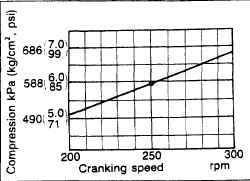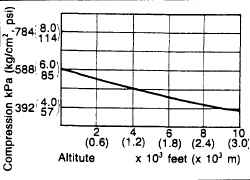Question: How do I check the compression in my engine, and what can I do about it if bad ?
If your engine lacks power and/or has a poor idle, it is a good idea to perform a compression test in order to (hopefully) eliminate the possibility of a bad engine. To perform a compression test, all is needed is a standard compression test kit (available at most auto parts store) and a helper.
The procedure is as follows:
- warm up engine to normal operating temperature and shut it off (a cold engine will give higher compression readings)
- disable ignition and fuel delivery (see faq about unflooding for which fuses should be removed)
- remove both trailing spark plugs (upper ones)
- screw in the tester's spark plug adapter (fitted with long reach adapter) into the spark plug hole (front when you are testing the front chambers and rear when you are testing the rear chambers)
- depress the pressure release valve on the tester (keep it depressed during the test)
- have your helper depress accelerator pedal fully and crank the engine for 5-10 seconds
- observe the bounces on the dial gauge
The bounces should be reaching approximately the same level. You are looking for even pulses but you are not too concerned about the actual PSI reading reached. Out of the three bounces, if one is much smaller than the other two, the diagnostic is a bad side seal (affects only one chamber) and if two are much smaller than the other one, the diagnostic is a bad apex seal (affects two chambers). Assuming the bounces are even, you now redo the whole procedure (well, just the cranking part of course) but this time you do not depress the pressure release valve. What you end up with is the compression figure you should compare with the FSM (85 psi is deemed acceptable). The figure you get should not be taken at face value because compression numbers depend highly on the rotation speed of the crankshaft. In my opinion, it is good to perform a compression test when you don't know if the engine is good or junk. To perform a compression test to determine whether the engine is good or better is a little bit tricky in my book. Also, remember that if the engine can idle nice and easy at 750 rpms, it is a probably a quite good engine.


The diagrams above show the influence of cranking speed and altitude on compression threshold readings. The threshold number given above (85 psi) assumes a cranking speed of 250 rpm and a sea-level altitude.
If the engine fails the compression test, it is wise to rebuild it or have it rebuilt. When doing a rebuild, all seals and gaskets should be changed. Rotors and rotor housings may not have to be changed depending on condition.
If the compression readings are relatively even but on the low side, it is possible some compression can be regained (assuming carbon deposits are the cause) by injecting water into the chambers via a vacuum hose (that has route to the two housings) with the engine running fast enough not to stall. I have tried this method that kinda steam cleans the engine internals using a vacuum line that connects to the nipple for the purge valve (see section about 'crankcase and evaporative' under 'emissions') in the back of the throttle body (bottom one among the two there). This is a trick commonly used by old-timers on piston engines. I don't really know the effect it has on the catalytic converters and other things so please use at your own risk.
Copyright © 2003 - The MAZDA RX-7 86-88 Technical Page - All Rights Reserved